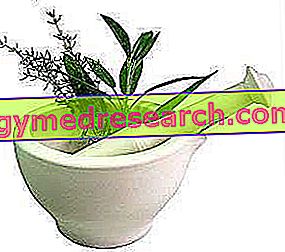Eggplants in history
Among the horticultural plants most cultivated in limited areas, eggplant, a vegetable originating from Asia introduced in the Sicilian territory as far back as the fifteenth century, certainly cannot be missing.
Eggplant affects a good portion of the horticultural production of the Bel Paese, so much so that about 250, 000 tons are produced per year.
Learn all about aubergines - watch the video
How to Clean Eggplants - Properties and Curiosities
X Problems with video playback? Reload from YouTube Go to Video Page Go to Video Recipes Section Watch the video on youtubeTerminology

Before being called "eggplant", the vegetable was the subject of a rather complex history in terms of nomenclature. The origins of the name do not date back to the Greek or Latin languages, considering that the vegetable was introduced into Europe by the Arabs: initially, these people named the current eggplant " badingian ", a term which, in the Italic language, later turned into " petronciano " . This last name, however, could create possible misunderstandings, therefore, in order to obviate the inconvenience, it was decided to modify the root of the term "petronciano" with the name of the most loved and absolute known fruit: the apple. Consequently, before assuming the definitive and currently accepted name, the aubergine was called melan-giana.
Botanical analysis
In botany, the eggplant is Solanum melogena, belonging to the Solanaceae family. We are talking about an annual herbaceous plant, clearly cultivated for its fruits, large showy and fleshy berries with dark skin, violet or white, and whitish and spongy flesh, with a bitter and spicy taste; the aubergines end in the apical part with a calyx, joined to the stem by a thorny peduncle.

The growth of aubergines is strongly influenced by the climate: when the temperature drops below 12 ° C, the development of the vegetable stops. The eggplant prefers rather warm, preferentially subtropical, never excessively rigid climates. The soil with neutral pH and enriched with organic substances is optimal for the ideal growth of the plant.
Variety
There are many varieties of aubergines, although the round and oval ones are by far the most appreciated.
The Violetta (Neapolitan, Palermitan, Nana) is an aubergine note with an elongated and cylindrical shape, very early and quite famous for its note of particular spiciness.
The Black beauty aubergine, progenitor of the Tonde, shows a very dark violet skin, and is typical of the Florentine countries. The eggplant meat is rather compact, appears little bitter to the taste and does not consist of many seeds. Among the rounded eggplants we also remember the White Round, with its typically light skin, sometimes tinged with pink: the plant does not require particular climatic requirements, therefore it is well suited to various climates and soils.
The Monstrous, decorated with this name to mock its particular enormous form, is an American eggplant, typical of New York.
Eggplant and solanine
Eggplants are said to be potentially toxic, responsible for sudden headaches and fever. This belief, at first glance paradoxical, presents a foundation of truth: raw aubergines, in fact, contain a considerable amount of solanine, a toxic glycosylated alkaloid substance (contained above all in sprouted potatoes and tomatoes). Taking excessive doses of solanine can create unpleasant side effects, such as drowsiness, irritation of the gastric mucosa, haemolysis, etc. The only way to remedy this problem is to cook the eggplant: with the heat treatment, the solanine present is reduced by half. After this in-depth analysis it is also understandable why the raw eggplant has a bitter and unpleasant taste; on the other hand, aubergines are very good after cooking (grilled, pan-fried, fried, in oil, baked, pasticciate etc.).
Nutritional values and cooking
Eggplants, although they are friends of low-calorie diets, can be caloric bombs depending on how they are cooked: the spongy paste of the vegetable absorbs a lot of seasoning, lending itself perfectly to flavor and to enrich very tasty and high-calorie dishes.

The raw eggplant only provides 18 Kcal per 100 grams; taking as reference an eggplant with an ideal weight of 100 grams, 92.7% is made up of water, while the remaining 7.3% is divided between carbohydrates (2.6%), fibers (2.6%), proteins and fat (traces).
Furthermore, the eggplant absorbs many mineral salts from the soil, in particular potassium, and is rich in fiber.
Video Recipes
Very Lightly Baked Eggplant Cutlets - With and Without Eggs
X Problems with video playback? Reload from YouTube Go to Video Page Go to Video Recipes Section Watch the video on youtubeSee all Recipes with Eggplant »
Active principles and properties
It seems that the eggplant has properties comparable to those of the artichoke, due to the presence of some molecules similar to the cynarin: in this regard, the vegetable is very useful for rebalancing liver function. By stimulating the activity of the liver, the eggplant also has cholesterol-lowering properties.
As described above, the aubergine is rich in potassium, while the content of phosphorus and calcium is rather modest, therefore it boasts discrete mineralizing potential.
Being a source of fiber, the vegetable is ideal in case of constipation: bland laxative properties are in fact attributed to the eggplant. Moreover, it is recommended in diets in case of anemia, atherosclerosis, oliguria and gout. Also known are the depurative, diuretic and anti-inflammatory virtues associated with aubergine. In ancient times, the eggplant leaves were used to prepare emollient cataplasms useful in case of abscesses, burns and hemorrhoids.
Eggplant in cosmetics
Eggplant is also used in cosmetics to prepare face creams and masks with high nourishing and moisturizing power. A "beauty" folk remedy is prepared with the crushed eggplant pulp: a good nourishing effect is obtained by applying the mixture on the skin of the face, preferably combined with yogurt.
For external use, it seems that the eggplant can also boast lightening properties.
Aubergine in brief, a summary of aubergines »



